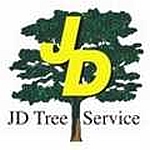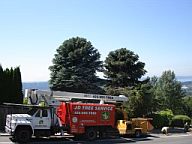Tree Service for King county, including Bellevue, Redmond, Sammamish, Issaquah, Kirkland, Woodinville, Bothell and Eastside.

JD Tree Service - Tree Care Tips
"When Quality is Your First Priority"
Contact us for a free estimate: 425-836-8800
Tree Care Tips & FAQ's
 The following misconceptions about tree care, and tips for hiring a tree service company will help you, the consumer, when it comes to hiring a tree service.
The following misconceptions about tree care, and tips for hiring a tree service company will help you, the consumer, when it comes to hiring a tree service.
Do not hire a company that tries to sell you on any tree care services listed below, as they are unneccessary and a waste of your time and money!
Tree Care Misconceptions
- Newly planted trees should be securely staked in order to develop a stable root system and a strong trunk.
- Some tree services may try to tell you to stake your new trees, don't do it without consulting a certified arborist. Staking is sometimes necessary, however it can have a negative effect on your tree. Unlike staked trees, unstaked trees are able to develop a larger root system and improve the shape of the trunk. The worst damage rendered on a staked tree is trunk damage from the staking wires or ties. If it does become necessary to stake your tree, remove staking materials after one year to avoid such irreparable damage.
- Newly planted trees should be heavily pruned to make up for loss of roots.
- The best way for a tree to become established is if it is not pruned. Pruning reduces the loss of water that evaporates from the leaves, but a full crown is absolutely necessary so the tree can produce the food and plant hormones that help with root growth. The bigger the crown, the stronger and larger the root system. Be extremely careful when it comes to pruning, there are very particular seasons and processes for pruning different types of trees. It is important to learn about it so as not to be lured into unneccessary or improper pruning.
- To encourage healing when removing a branch from a tree, the final cut should be flush with the stem.
- Not true. Tree wounds do not "heal" as human wounds, which regenerate tissue in a similar fashion of that which was removed. When trees have a wound, they compartmentalize it by creating woundwood over the affected area. If flush cutting occurs, the "branch collar" is removed, creating an even larger wound. It is important to minimize the wound by leaving a "branch collar", a small amount of the cut branch. This prevents the loss of the parent branch tissue and chance of decay throughout the tree.
- Some types of fast-growing, weak-wooded trees such as silver maple, should be "topped" to make them less hazardous to landscape.
- Although topping these trees may seem like a good idea initially, it will lead to more danger in the future. Topping of trees boosts the growth of twigs below the cuts. These twigs or shoots lead to branches with weak attachments, futhermore decay spreads inside the branches and stubs that were topped. The tree will regain its height within 2-5 years, but will be more hazardous than before because of the weak attachments and possible decay. Instead of topping, we suggest, thinning, cabling or possibly removal and replacing the hazardous tree with a more suitable species.
- Pruning certain species of trees in the spring will stress out the tree causing health problems or "bleeding".
- Some trees like maples and birches will seem like they are "bleeding" because of loss of sap if pruned in the early spring. However, this sort of bleeding does not hurt the tree. For the most part, routine pruning can be done any time of the year. However, the worst time to prune is just as the tree has leafed out in the spring. The very best time is when the tree is dormant, November through January. Pruning at this time of year will maximize flowering for the following year.
- The crown of a tree should be cut back to compensate for damage or loss of root system commonly due to construction.
- The best way for a tree to become established is if it is not pruned. Pruning reduces the loss of water that evaporates from the leaves, but a full crown is absolutely necessary so the tree can produce the food and plant hormones that help with root growth. The bigger the crown, the stronger and larger the root system. Be extremely careful when it comes to pruning, there are very particular seasons and processes for pruning different types of trees. It is important to learn about it so as not to be lured into unneccessary or improper pruning.
- Newly planted trees should be heavily pruned to make up for loss of roots.
- This is an extremely common recommendation with no scientific grounding. It has been found that trees left unpruned following root loss actually respond better than trees that are pruned. If you think about it, it makes more sense to leave the tree be as the more branches it has, the more food the tree will produce in the leaves. It is likely that the tree will lose some branches, if it survives at all, but it is better to allow the tree to decide which ones.
Additional Tips
- When hiring a tree service be sure to follow these guidelines...
- Look for ISA certification (if consulting an arborist specifically), or membership in associations such as ISA (International Society of Arboriculture).
Ask for proof of insurance, license, and bond, be wary of anyone going door-to-door trying to scare you into doing unnecessary tree work, and don't be afraid to ask for references. If a tree service cannot provide proof of any of these things, they're not a reputable company.
Ask about their safety record and if there has been any insurance claims against them, then check those references. You can look up any tree service at www.lni.wa.gov to find out more information about them e.g. license suspensions, accident claims, safety record, etc.
- Can you give me an estimate over the phone?
- Due to the nature of this business, it is not possible to give our customers an accurate estimate without first seeing the job you have in mind. It is for that reason that it is impossible to give an estimate over the phone, or via the Web.
Our goal is to provide you with the most dependable estimate possible so that you may make the best decision to fit your budget and individual needs. We will do all we can to make an appointment at the most convenient time for you so that we may visit you, closely examine the job, answer any questions you may have and provide you with an accurate estimate.
Please contact us at (425) 836-8800 or email us at jd_treeservice@yahoo.com to schedule an estimate appointment. Have an emergency? We will work with you to set up a meeting time as soon as possible.
 We are professional, trained members of the International Society of Arboriculture.
We are professional, trained members of the International Society of Arboriculture.